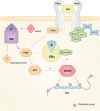Tau Phosphorylation in Female Neurodegeneration: Role of Estrogens, Progesterone, and Prolactin
- PMID: 29643836
- PMCID: PMC5882780
- DOI: 10.3389/fendo.2018.00133
Tau Phosphorylation in Female Neurodegeneration: Role of Estrogens, Progesterone, and Prolactin
Abstract
Sex differences are important to consider when studying different psychiatric, neurodevelopmental, and neurodegenerative disorders, including Alzheimer's disease (AD). These disorders can be affected by dimorphic changes in the central nervous system and be influenced by sex-specific hormones and neuroactive steroids. In fact, AD is more prevalent in women than in men. One of the main characteristics of AD is the formation of neurofibrillary tangles, composed of the phosphoprotein Tau, and neuronal loss in specific brain regions. The scope of this work is to review the existing evidence on how a set of hormones (estrogen, progesterone, and prolactin) affect tau phosphorylation in the brain of females under both physiological and pathological conditions.
Keywords: estrogen; hippocampus; neurodegenerative disease; neuroprotection; progesterone; prolactin; reproduction; tau phosphorylation.
Figures


References
Publication types
LinkOut - more resources
Full Text Sources
Other Literature Sources

